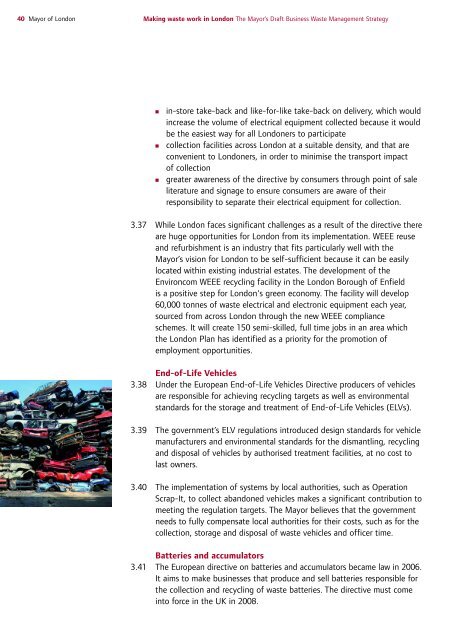Draft Business Waste Strategy PDF - london.gov.uk - Greater ...
Draft Business Waste Strategy PDF - london.gov.uk - Greater ...
Draft Business Waste Strategy PDF - london.gov.uk - Greater ...
You also want an ePaper? Increase the reach of your titles
YUMPU automatically turns print PDFs into web optimized ePapers that Google loves.
40 Mayor of London<br />
Making waste work in London The Mayor’s <strong>Draft</strong> <strong>Business</strong> <strong>Waste</strong> Management <strong>Strategy</strong><br />
■ in-store take-back and like-for-like take-back on delivery, which would<br />
increase the volume of electrical equipment collected because it would<br />
be the easiest way for all Londoners to participate<br />
■ collection facilities across London at a suitable density, and that are<br />
convenient to Londoners, in order to minimise the transport impact<br />
of collection<br />
■ greater awareness of the directive by consumers through point of sale<br />
literature and signage to ensure consumers are aware of their<br />
responsibility to separate their electrical equipment for collection.<br />
3.37 While London faces significant challenges as a result of the directive there<br />
are huge opportunities for London from its implementation. WEEE reuse<br />
and refurbishment is an industry that fits particularly well with the<br />
Mayor’s vision for London to be self-sufficient because it can be easily<br />
located within existing industrial estates. The development of the<br />
Environcom WEEE recycling facility in the London Borough of Enfield<br />
is a positive step for London's green economy. The facility will develop<br />
60,000 tonnes of waste electrical and electronic equipment each year,<br />
sourced from across London through the new WEEE compliance<br />
schemes. It will create 150 semi-skilled, full time jobs in an area which<br />
the London Plan has identified as a priority for the promotion of<br />
employment opportunities.<br />
End-of-Life Vehicles<br />
3.38 Under the European End-of-Life Vehicles Directive producers of vehicles<br />
are responsible for achieving recycling targets as well as environmental<br />
standards for the storage and treatment of End-of-Life Vehicles (ELVs).<br />
3.39 The <strong>gov</strong>ernment’s ELV regulations introduced design standards for vehicle<br />
manufacturers and environmental standards for the dismantling, recycling<br />
and disposal of vehicles by authorised treatment facilities, at no cost to<br />
last owners.<br />
3.40 The implementation of systems by local authorities, such as Operation<br />
Scrap-It, to collect abandoned vehicles makes a significant contribution to<br />
meeting the regulation targets. The Mayor believes that the <strong>gov</strong>ernment<br />
needs to fully compensate local authorities for their costs, such as for the<br />
collection, storage and disposal of waste vehicles and officer time.<br />
Batteries and accumulators<br />
3.41 The European directive on batteries and accumulators became law in 2006.<br />
It aims to make businesses that produce and sell batteries responsible for<br />
the collection and recycling of waste batteries. The directive must come<br />
into force in the UK in 2008.
















